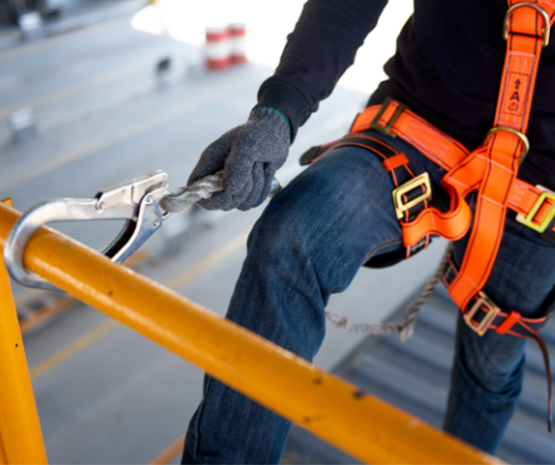
No matter your industry, falls are one of the most common ways that your employees can get hurt. In 2020 alone, 211,640 individuals missed time at work due to a slip, trip, or fall, while 805 people ultimately died from their injury. Due to these dangers, the Occupational Safety and Health Administration (OSHA) makes it clear that employers must take specific measures to protect employees from slips, trips, and falls.
Fall protection is one way that employers can create a safer workplace and prevent fall injuries. Keep reading for an overview of what employers need to know about fall protection and how to protect your employees from devastating injuries.
What Are OSHA’s Fall Protection Standards?
OSHA has developed multiple rules to protect workers from serious work-related injuries caused by falls. The first part of these regulations starts with broader requirements to maintain compliance and limit the effect of potential danger areas.
- Give employees working conditions that are free of known dangers.
- Maintain floors in work areas so that they are clean and as dry as possible.
- Select proper personal protective equipment and provide it to workers at no cost.
- Train workers about job hazards in a language that they can understand.
OSHA also requires employers to take specific measures to address fall risks. The employer must take the following actions to limit the employees’ chances of injuries caused by falls Use railings, toe boards, and floor hole covers to protect workers from walking into any floor holes.
- Provide a guard rail and toe board around any elevated open-sided platform, floor or runway.
- Install guardrails and toe boards around any dangerous machines and equipment if employees can fall into or onto them, regardless of the height.
- Set up or provide any other means of fall protection that may be required depending on the job or environment, such as safety nets, stair railings, and other safety measures.
It’s also important to note that OSHA has specific fall protection standards for the construction industry. According to the Bureau of Labor Statistics, 37.9% of fatal construction injuries came from slips, trips, and falls, making fall protection essential. OSHA lays out additional fall safety standards in the Code of Federal Regulations – 29 CFR 1926.501.
At What Height Is Fall Protection Required?
OSHA requires all businesses to prepare their workplace so that employees are less likely to fall from elevated places or into any holes. OSHA uses a “minimum height” measurement to judge which places are considered elevated risks. However, the minimum height for elevated places depends on the type of work being completed on the job site. These heights include the following designations:
- General industry workplaces – four feet
- Shipyards – five feet
- Construction – six feet
- Longshoring operations – eight feet
What Are The Basic Types Of Fall Protection Equipment?
There are multiple forms of fall protection. These safety measures are designed to cover the entire spectrum of fall protection needs, from preventing an initial fall to saving employees from contact injuries after a fall occurs. The basic types of fall protection include:
- Barriers – These are physical obstacles that prevent people and objects like tools from falling over the edge of a platform or into an open hole. Guardrails and toe boards are the most common version of fall protection barriers.
- Travel restriction – These restraints are designed to prevent workers from getting too close to an unprotected edge or another form of a fall hazard. For example, a safety harness or belt will be connected to a lifeline that is adjusted to allow users to travel a limited distance.
- Work positioning – A work positioning system allows workers to work in a secure, anchored space where they can freely use their hands, such as a swing stage or a suspended chair. These systems shouldn’t allow individuals to fall more than two feet and be combined with fall arrest equipment.
- Fall arrest – Fall arrest systems are emergency measures that prevent users from making contact after a fall. Equipment like safety nets, shock absorbers, and rope grabs limit the total fall distance and protect employees from injuries and potential fatalities.
- Control zones – In cases where it is impractical to use fall protection systems, control zones are defined areas with safety monitors that limit access to only approved workers.
What Fall Protection Training Is Required?
In addition to providing safety measures, OSHA also deems employers responsible for training employees on a variety of fall protection safety topics. Employees should be trained by OSHA-approved trainers and all information should be easily understood by the employee. These lessons should cover the following subjects:
- What are considered fall hazards, how employees can be injured, and how to recognize these fall hazards.
- Existing policies and procedures that employees must follow to minimize those hazards.
- The exact procedures employees should use to correctly install, inspect, operate, maintain, and disassemble their personal fall protection systems and equipment.
- How to correctly use the personal fall protection systems and equipment required on a job site.
Protect Your Business Through Proper Fall Protection
Whether you’re employees are working from heights or walking around an office, it’s essential to prevent falls wherever they can happen. Of course, fall protection isn’t always as simple as putting in guardrails and investing in equipment. It can take a lot of work and expertise to invest in workplace safety, and business owners only have so much free time.
Fortunately, GMS helps businesses take a proactive approach to workplace safety. Our experts can conduct jobsite inspections, provide industry-specific training, and develop safety documentation for your business. These and other actions will help ensure that your employees are safer and your business stays compliant with OSHA regulations.
Ready to make your business a safer place? Contact GMS today to talk to one of our experts about our workplace safety services and other critical HR functions.